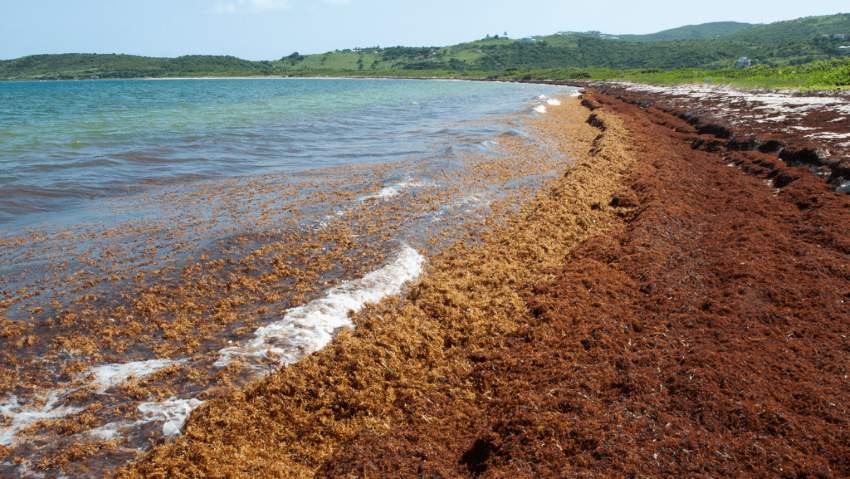≡-Sargassum Crisis in Belize: How Emergency Cleanup Grants Are Saving Coastal Tourism and Marine Life – Viral of Today
<> Viral of Today <>
Home » America Travel News » Sargassum Crisis in Belize: How Emergency Cleanup Grants Are Saving Coastal Tourism and Marine Life Published on
August 29, 2025Coastal communities of Belize are familiar with sargassum, the brown, tangled seaweed that has been washing up along the country’s shores more and more. But the current sargassum crisis is unprecedented in its scope. An extraordinary accumulation of seaweed has overtaken Belize’s coastal areas this year, seriously disrupting the country’s ecology, society, and economy.The invasion is being directly observed by the people who live in coastal villages such as San Pedro, Caye Caulker, Placencia, and Hopkins. The effects of this influx are extensive, ranging from the suffocation of marine life to the release of foul-smelling gases as the seaweed breaks down. In addition to detracting from Belize’s beaches’ natural beauty, it has a negative effect on local tourism, which is vital to the nation’s economy.A National Challenge: Addressing the Sargassum CrisisThe Belize Fund for a Sustainable Future, recognising the severity of the problem, has stepped in to support the cleanup efforts. The Fund, a private entity established to bolster Belize’s marine conservation efforts, has allocated a generous $250,000 to support impacted communities along the coast. This emergency relief grant aims to assist in the immediate removal of the sargassum and provide much-needed financial relief to businesses and residents struggling with the ongoing invasion.These funds are being distributed through a partnership with the Belize Hotel Association and the Belize Tourism Industry Association, two organisations that play a pivotal role in supporting Belize’s tourism sector. The relief effort targets tourism-related businesses, from small resorts to larger hotels, to help them manage the overwhelming cost of cleanup efforts.While the initial wave of funding offers immediate assistance, the true goal is to sustain Belize’s long-term recovery efforts and ensure that the tourism industry can continue to thrive despite the recurring problem.Who Can Apply for the Relief Grant?The relief fund is open to businesses located along Belize’s coast that are actively dealing with the sargassum situation. From small beachfront resorts to tour operators and local enterprises, anyone engaged in fighting the invasion can apply for a grant of up to $5,000.One of the key features of this programme is that businesses do not need to be members of the Belize Hotel Association or the Belize Tourism Industry Association to qualify for assistance. The application process is designed to be inclusive and transparent, allowing all eligible businesses to access the funds needed to address the crisis.Businesses located in key coastal areas such as San Pedro, Caye Caulker, Placencia, Hopkins, and Seine Bight are encouraged to apply. Once the application process officially opens, businesses will be able to submit their forms online, and guidelines detailing the criteria for approval will be readily available. The goal is to make the application process as smooth and accessible as possible.How Will the Funds Be Used?The $250,000 grant is expected to be used primarily for labour-related expenses. As the seaweed washes ashore, the most effective solution is manual removal, often requiring additional workers to assist with clearing the beaches. Many businesses, especially small resorts and family-run operations, simply cannot bear the cost of hiring additional staff for such an intensive and ongoing task.In addition to labour costs, the funds may also be used to purchase essential equipment such as rakes, wheelbarrows, and other tools necessary for the efficient removal of sargassum. While various technologies, such as beach rakes, can aid in the cleanup process, human resources remain the backbone of the effort. The relief fund will help businesses bolster their workforce, ensuring that cleanup operations can continue without interruption.Long-Term Relief: A First Step in a Prolonged BattleWhile this emergency grant provides immediate relief, it is not a permanent solution to the sargassum issue. Belize has been grappling with the impacts of sargassum invasions since at least 2011, and the problem has steadily worsened over the years. The influx of sargassum is driven by global climate changes and shifting ocean currents, making it a challenge that requires a coordinated, long-term strategy.The Belize Fund for a Sustainable Future has emphasised that beyond this immediate relief, the organisation will continue to explore ways to support the blue economy and coastal communities. This could include future funding initiatives, scientific research, and policy advocacy aimed at mitigating the long-term impacts of sargassum on Belize’s environment and economy.In addition to the Belize Fund’s efforts, the Belizean government has also taken steps to address the crisis. Government officials have acknowledged the scale of the problem and are working on broader initiatives to enhance the country’s resilience against recurring sargassum invasions. Measures include the establishment of designated sargassum collection sites and support for the development of more advanced seaweed removal technologies.Why Sargassum Matters Beyond the BeachesThe sargassum invasion is not just a cosmetic issue; it poses significant threats to marine ecosystems, human health, and the country’s economy. Decaying sargassum releases harmful gases such as hydrogen sulphide, which can pose health risks to both humans and wildlife. Additionally, as it clogs coral reefs and other marine habitats, it deprives marine life of vital resources such as sunlight and oxygen.For Belize’s tourism industry, the crisis has created a double-edged sword. On one hand, the country relies heavily on its pristine beaches to attract visitors from around the world. On the other hand, the costs associated with cleaning up the sargassum are substantial, putting a strain on businesses already struggling with the challenges of the pandemic and global travel restrictions.Moving Forward: A Collaborative EffortThe government of Belize, conservation groups, and the travel and tourism sector have united in their response to the sargassum crisis. The $250,000 relief fund is only the first step. It will take consistent collaboration across all sectors as Belize struggles with the effects of climate change in order to safeguard its marine environments, coastal communities, and the livelihoods of those who depend on them.This effort is a crucial first step in resolving the crisis, even though it cannot reverse the harm done by years of rising sargassum levels. Belize can preserve its natural beauty for future generations by working together and coming up with creative solutions.[Image Source: Atlantic Oceanographic and Meteorological Laboratory]
This information will surprise you!
See also
- Read until the end to discover everything.
- Important information you need to know.
- Interesting facts and helpful tips.
Conclusion
Did you enjoy the news? Keep following us daily!













